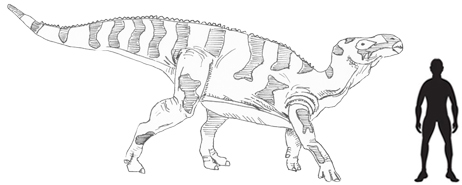The largest stem tetrapod known to have digits has been scientifically described. Named Gaiasia jennyae it lurked in the chilly waters of a Namibian swamp around 280 million years ago (Cisuralian Epoch of the Early Permian). Its discovery indicates a more global distribution of continental stem tetrapods during the Carboniferous-Permian transition. Although no complete skeleton is known, G. jennyae was probably more than two metres in length. The skull measures around sixty centimetres long. It was probably an ambush predator, relying on suction capture to grab and swallow any prey item unfortunate to swim too close. Once in the mouth, there was no escape as the jaws were lined with large fangs.

Gaiasia jennyae life reconstruction. A newly described stem tetrapod from a high palaeolatitude (approximately fifty-five degrees south). Picture credit: Gabriel Lio.
Picture credit: Gabriel Lio
Gaiasia jennyae Honouring the Late Professor Jenny Clack
Writing in the journal “Nature”, the scientists describe Gaiasia as a stem tetrapod, one from a high palaeolatitude (approximately fifty-five degrees south). This is a significant fossil discovery, most other stem tetrapods from the Early Permian are known from palaeoequatorial regions. The genus name is derived from the Gai-As Formation of Namibia. The species name honours the late Professor Jenny Clack (1947–2020), in recognition for her ground-breaking work studying early tetrapods.
Tetrapods are four-limbed vertebrates (amphibians, reptiles, mammals and birds), that evolved from lobe finned fishes (Sarcopterygii).
To read an article from 2013, highlighting the work of Professor Jenny Clack on Ichthyostega: Ichthyostega Gets a Makeover.
Co-lead author of the study, Jason Pardo (NSF postdoctoral fellow at the Field Museum in Chicago) commented:
“Gaiasia jennyae was considerably larger than a person, and it probably hung out near the bottom of swamps and lakes. It’s got a big, flat, toilet seat shaped head, which allows it to open its mouth and suck in prey. It has these huge fangs, the whole front of the mouth is just giant teeth. It’s a big predator, but potentially also a relatively slow ambush predator.”

A photograph of some of the prepared Gaiasia jennyae fossil material. Picture credit C. Marsicano
Picture credit: C. Marsicano.
Interlocking Large Fangs
The presence of such a large predator in the environment indicates that there was a rich and diverse ecosystem present. Palaeontologists are aware that in the equatorial regions of Pangaea new four-limbed vertebrates (Tetrapodomorpha) were evolving. However, in higher palaeolatitudes more ancient creatures persisted.
Co-lead author of the research Claudia Marsicano (University of Buenos Aires) explained:
“When we found this enormous specimen just lying on the outcrop as a giant concretion, it was really shocking. I knew just from seeing it that it was something completely different. We were all very excited. After examining the skull, the structure of the front of the skull caught my attention. It was the only clearly visible part at that time, and it showed very unusually interlocking large fangs, creating a unique bite for early tetrapods.”
Several specimens were discovered, including one with a well-preserved, articulated skull and spine. Although there might be a bias in fossil preservation, the number of individuals found suggests that Gaiasia jennyae was relatively common in the ancient Namibian cold-water swamp habitat.

Gaiasia jennyae fossil excavation in the Namibian desert. Claudia Marsicano examining nodules containing fossil bones. Picture credit: Roger M. H. Smith.
Picture credit: Roger M. H. Smith
Applying Bergmann’s Rule
With several specimens to study, the team were able to conduct an in-depth phylogenetic analysis. The analysis indicates that Gaiasia might be related to other early tetrapods that became extinct around forty million years earlier. This suggests that in highly palaeolatitudes “relic” taxa could still be found.
Namibia today, is located much further north than it was approximately 280 million years ago. During the Cisuralian Epoch of the Early Permian, this area was a cold-water swamp. At this time in Earth’s history, a global Ice Age was drawing to a close. Equatorial regions were drying up and becoming more forested, but closer to the poles, swampy habitats persisted, potentially alongside patches of ice and glaciers.
The Biggest Suction-feeding Tetrapod from the Palaeozoic
As the largest Palaeozoic suction-feeding tetrapod known to science, it is also possible that Gaiasia may reflect thermophysiological constraints associated with cold-temperate climates in alignment with Bergmann’s rule. Bergmann’s rule states that organisms in cold environments tend to be larger than their counterparts in warmer regions. Larger organisms tend to be better at conserving heat.
Jason Pardo stated:
“Gaiasia is a stem tetrapod. It is a holdover from that earlier group, before they evolved and split into the groups that would become mammals, birds, reptiles and amphibians, which are called crown tetrapods. It’s really, really surprising that Gaiasia is so archaic. It was related to organisms that went extinct probably 40 million years prior.”
Intriguingly, for a relic of an older lineage, Gaiasia is doing more than just holding its own.
Pardo added:
“There are some other more archaic animals still hanging on 300 million years ago, but they were rare, they were small, and they were doing their own thing. Gaiasia is big, and it is abundant, and it seems to be the primary predator in its ecosystem.”
Everything Dinosaur acknowledges the assistance of a media release from the Field Museum in Chicago in the compilation of this article.
The scientific paper: “Giant stem tetrapod was apex predator in Gondwanan late Palaeozoic ice age” by Claudia A. Marsicano, Jason D. Pardo, Roger M. H. Smith, Adriana C. Mancuso, Leandro C. Gaetano and Helke Mocke published in Nature.
The award-winning Everything Dinosaur website: Prehistoric Animal Models.




























